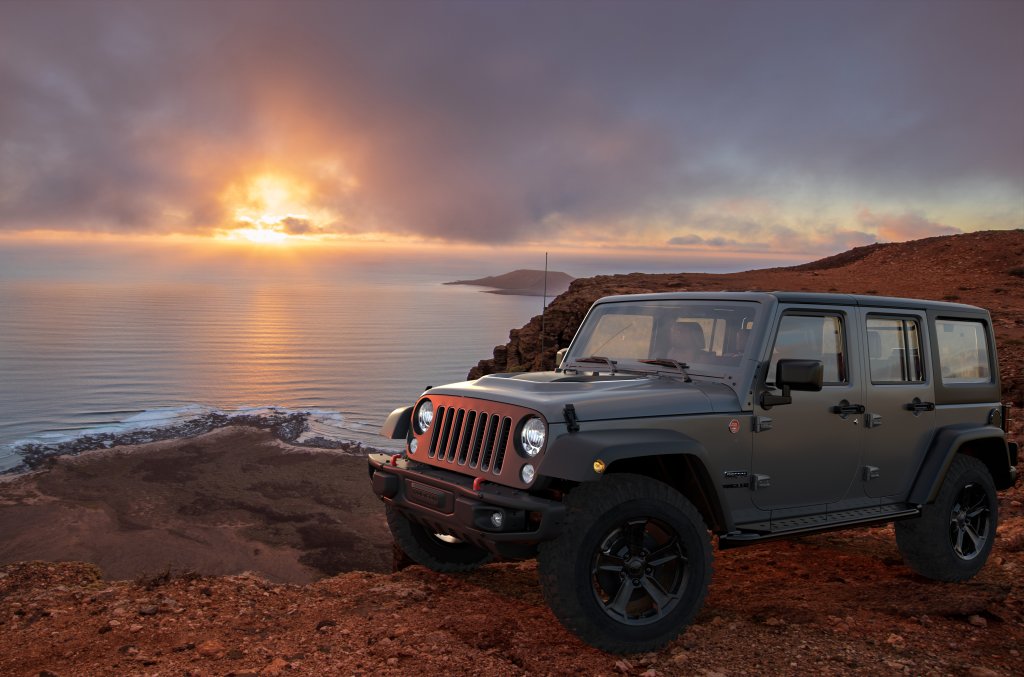Tracing lineage all the way back to World War II, the Jeep Wrangler is a long-running 4×4 with few equals. It is a vehicle that inspires die-hard customer loyalty thanks to a unique combination of unstoppable off-roading and open-air adventuring.
Known for a reliable straight-6 early on followed by the potent Pentastar V6 more recently, the Wrangler is built tough. However, as with any vehicle, there has been trouble along the way, which is why we’ve put together this ranking of the best and worst model years based on objective FIXD Reliability scores and subjective owner input – as detailed below.
| Best Years | Why? | Worst Years | Why? |
| 2019-2021 |
Perfect reliability scores in both categories |
2001-2002 |
All-time reliability lows, poor fuel economy |
| 2017 |
Good Reliability, maintenance cost drop >> See 2017 Jeep Wranglers for sale
|
2005 |
High service costs, reliability plummets |
| 2012-2016 |
Well-executed arrival of new V6 |
2007-2009 |
Teething problems with 3rd-gen model |
| 2010 |
Both reliability scores improve, solid safety score |
2011 |
Significant drops in reliability & safety score |
| 2006 |
FIXD Reliability score spikes by 4 points |
2018 |
New 4th-gen model reliability issues |
| 2003-2004 |
New powertrain is more reliable |
Jeep Wrangler Engine Reliability Score, Safety Ratings, MPG, and Value v.s. Maintenance & Repair Costs Year by Year
The first chart below, Jeep Wrangler Reliability Score, is the main driver of our model year rankings. It is a combination of objective FIXD device data and subjective owner-reported information. Typically the first year of a new generation – like 2007 and 2018 – will struggle with reliability as the kinks are worked out, which is reflected in the chart.
From there, we blend in published government safety scores from the National Highway Traffic Safety Administration (NHTSA) and fuel efficiency figures per fueleconomy.gov.
We also incorporate market values from Kelley Blue Book (KBB) against owner-reported annual maintenance costs. That goes into the ranking decision along with owner survey answers and pertinent safety recalls. Lastly, with details on safety recalls and common Diagnostic Trouble Codes (DTCs), we can create the final rankings below.
Engine Reliability Score – Over The Years
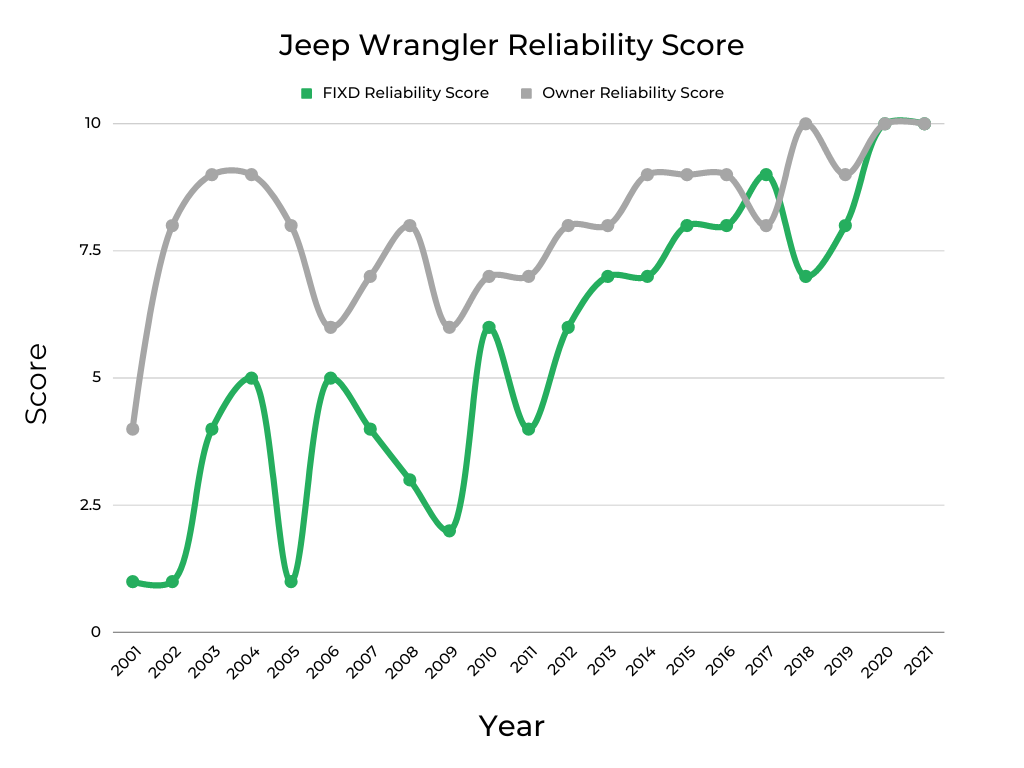
The green line on this Jeep Wrangler Reliability Score chart is based on the number of CELs thrown by each model year. After tallying them up, we weight this objective score by mileage and convert it into a 1-10 scale where 10 is the best and 1 is the worst.
By asking Wrangler owners, “How reliable would you say your car is?”, we can pull together a subjective reliability score for comparison. This multiple-choice question offers answers from “Just Point A to Point B driving” to “I could take a cross-country trip, no problem.” After converting the answer into a 1-10 scale, we create the gray line above.
As you can see, the objective and subjective reliability scores mostly move in the same direction. But occasionally, like in 2008 and 2018, the scores diverge dramatically. We’ll explain this in the relevant sections below but it helps illustrate the importance of analyzing both sets of data.
You can find out more about our reliability scoring process at the bottom of this article and learn about some of the most common CELs to expect from Jeep.
NHTSA Safety Score – Over The Years

As you can see on the chart above, the Jeep Wrangler (green line) generally underperforms the auto industry average (gray line) when it comes to safety. Part of that can be attributed to the fact that the Wrangler has historically offered fewer safety features than the competition. For example, side curtain airbags for first- and second-row occupants are only standard as of the 2024 model year.
Also notable is the dramatic dip in 2011 that resulted from the NHTSA modifying its testing protocol that year to be more strenuous. It had a significant impact on the Wrangler’s safety score, which remained that way until 2020. Both the gray line – average crash test safety rating across the industry – and the green line – Jeep Wrangler safety ratings – illustrate data published by the NHTSA.
Understanding how a given model year of the Wrangler ranks for safety is important as it plays a big role in keeping insurance premiums down. If you live in one of the states listed below, we can show you the cheapest vehicles to insure in yours.
| What Used Cars Are the Cheapest To Insure In: |
| Ohio |
| North Carolina |
| Michigan |
| Georgia |
| Texas |
| New York |
| Illinois |
| Pennsylvania |
| California |
MPG – Over The Years
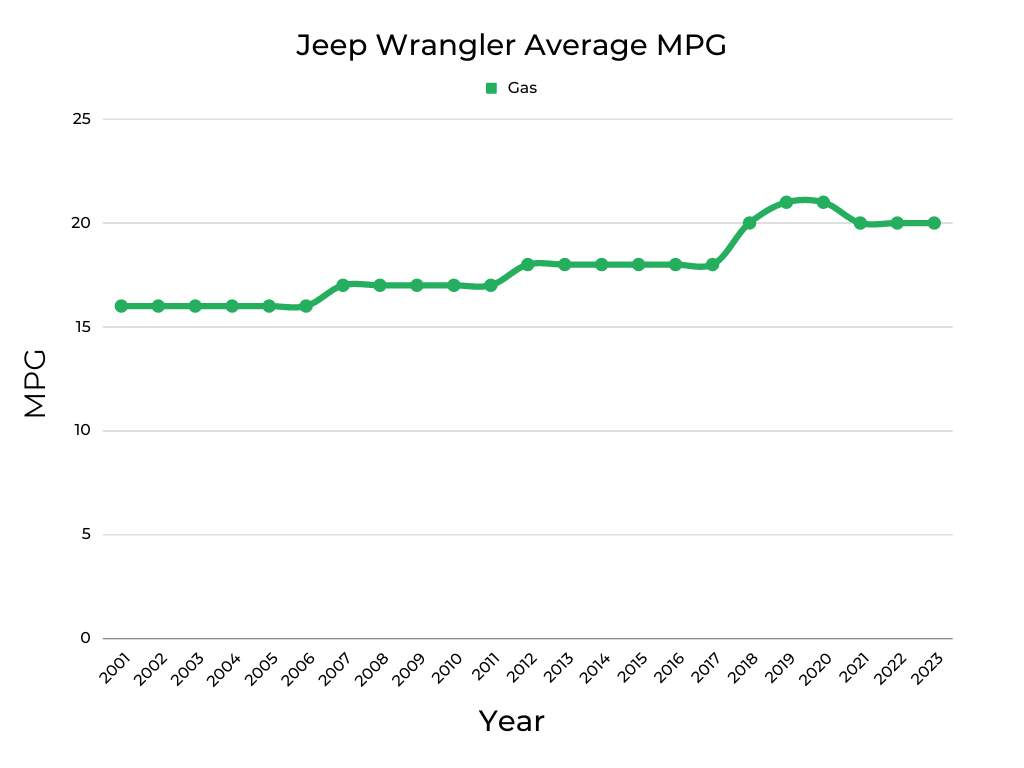
By averaging the combined fuel economy figures – from fueleconomy.gov – across all trims of each model year, we can create the above Jeep Wrangler Average MPG chart. As with most vehicles, the Wrangler’s fuel economy typically increases from one generation to the next as engines and transmissions become more efficient and technology improves.
The most notable improvement in fuel economy can be seen in the 2018-2020 range when the average stepped up by 2-3 mpg thanks to the debut of a more fuel-efficient 4th-gen Wrangler followed by a diesel powertrain.
Current Market Value of All Jeep Wrangler Years & Cost Per Year to Repair and Maintain Each

This chart plots current Jeep Wrangler market values from KBB against annual maintenance costs per owner surveys. It’s a valuable set of data points in defining why some model years are best avoided. For example, values began to swoon from 2001 into 2002, which is one reason these Wranglers are on our list of models to avoid.
If you’d like to learn about this vehicle’s past depreciation rate & our projected depreciation rate based on that, check out: Jeep Wrangler | Depreciation Rate & Curve Graphed.
When shopping for a used Jeep Wrangler it’s important to keep in mind that not all vehicles are cared for equally. To protect yourself from lemons, take along a FIXD Sensor on your test drive. FIXD connects to a free app on your smartphone to tell you more about the vehicle you’re checking out, including check engine lights and other hidden issues that the owner or dealership may be attempting to hide. Click here to learn more and get FIXD for only $19.99 (regular price $59)!
Important Features Timeline

1996: Technically, there is no model year 1996 Wrangler as first-gen (YJ) production ends
1997: Arrival of second-gen Wrangler (TJ), leaf springs replaced by coils
1998: Torsion bar revisions improve steering, cruise control made optional
1999: Sliding HVAC controls are replaced by rotary-style knobs
2000: 4.0L inline-6 is revised, new 5-speed manual transmission
2001: Soft top is upgraded for less noise while driving, new gauge cluster design
2002: X model debuts along with improved premium sound system
2003: New 2.4L inline-5, new 4-speed automatic transmission, Rubicon debuts
2004: Original 2-door Unlimited model arrives
2005: New 6-speed manual replaces 5-speed unit
2006: 2.4L four-cylinder dropped, 4.0L model becomes standard
2007: New third-gen model (JK) is larger and more refined with new 3.8L V6 powertrain
2008: Sahara & Rubicon trim get standard Sunrider soft top
2009: Hill Start Assist made standard, small storage net added under center stack
2010: Cloth upholstery replaces vinyl on base models, revised soft top folding mechanism
2011: Mid-cycle refresh focuses on cabin upgrades including Bluetooth connectivity
2012: 3.6L Pentastar V6 replaces 3.8L mill, new 5-speed automatic debuts
2013: Seats are recontoured for more comfort
2014: 6.5” infotainment touchscreen offered on Sport models
2015: Base audio system upgraded to 8 speakers, optional Alpine system bumped to 9
2016: New colors added to paint palette, 75th Anniversary Edition model arrives
2017: LED headlights become optional along with Cold Weather package
2018: Golden Eagle nameplate is revived for a special edition Wrangler
2019: Fourth-gen model (JL) debuts with revised V6, new four-cylinder, and new 8-speed automatic
2020: 3.0L diesel-powered V6 powertrain arrives
2021: V8-powered Rubicon and plug-in hybrid variants are unveiled
2022: High Tide and Beach models become latest in a long line of special editions
The Best Years of the Jeep Wrangler
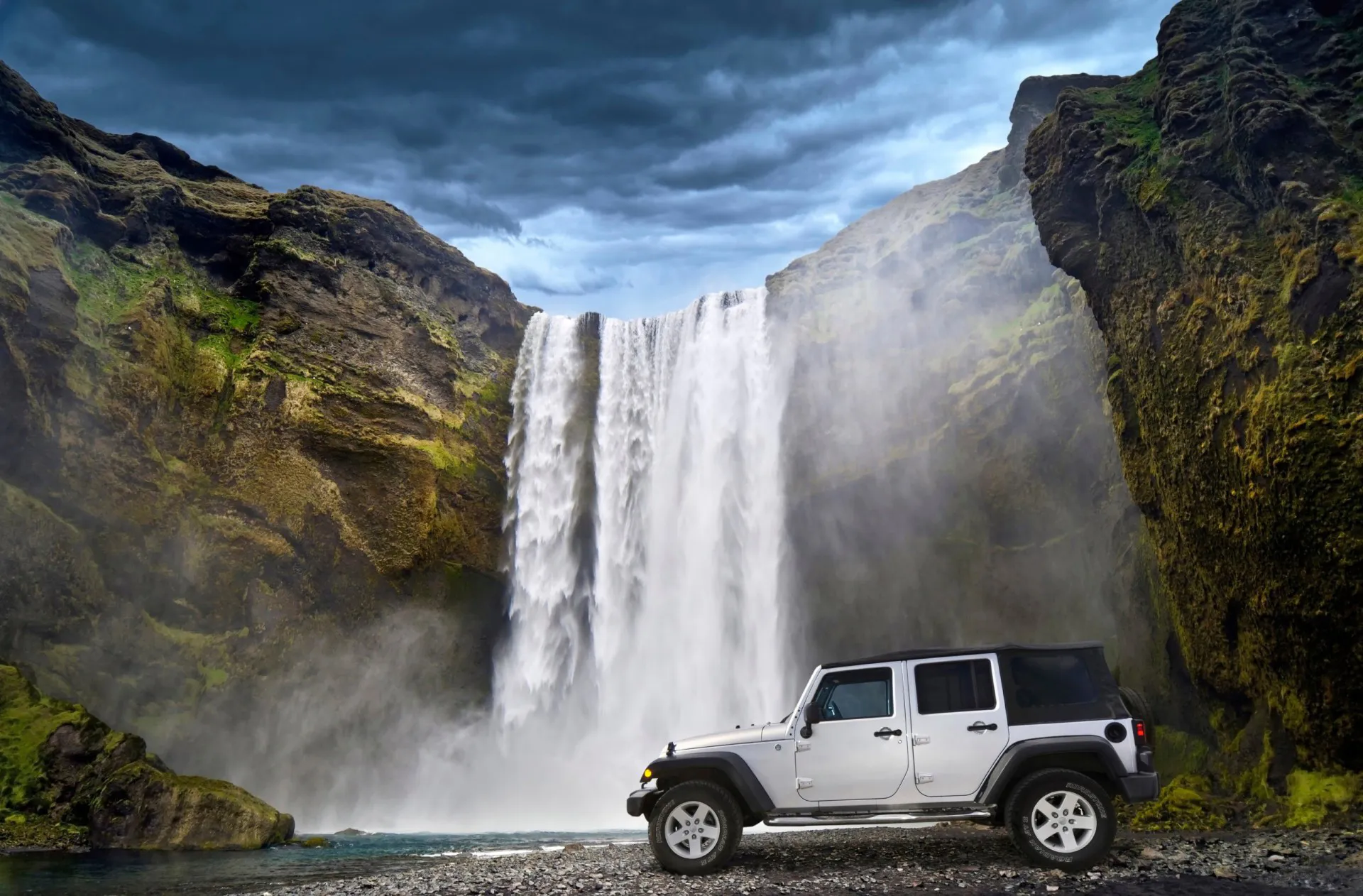
Taking into account FIXD and Owner reliability, government safety scores, fuel efficiency, and Wrangler owner survey responses, we’ve come up with this list of the best Jeep Wranglers. Pertinent recall information and notes about common DTCs are included as well.
2019-2021 Jeep Wrangler
FIXD App Engine Reliability: 8-10/10
Owner-Reported Reliability: 9-10/10
KBB Value: $28,391-$32,283
Fuel Economy: 20-21 mpg
Annual Maintenance/Repair: $295-$321
Safety Rating: 3-3.7/5
Jeep has been busy on the Wrangler powertrain front of late, adding a diesel, plug-in hybrid, AND V8 powertrain to the mix since 2020. Usually, this spells disaster for reliability and yet, these 2019-2021 Wranglers are at the top of the game with perfect FIXD Reliability scores in 2021 and 2021 that align with the owner reliability score.
The 2019 model year is included because it represents an improvement over the prior year when the fourth generation debuted. As well, the safety score pops in 2020 which coincides with the arrival of adaptive cruise control and forward collision warning that year.
Other high points include a steady increase in KBB market values and all-time lows for annual maintenance costs. Finally, thanks to a more efficient fourth-gen powertrain and diesel option, overall fuel economy hits the highest level of any Wrangler going back 20 years.
Looking over Wrangler owner surveys, we can see that these model years spend less time than average in the shop each year, though the sub-50,000-mile odometer readings do help with that. As well, 38% of 2021 owners report using their Wrangler for off-road duty. That’s high, even for the Wrangler, no doubt helped by the arrival of the wild V8-powered Rubicon model that year.
Annual maintenance costs are low, less than $350 for all three years, which aligns with the relatively low costs to repair the most common problems. DTC P0562 likely means it’s time for a replacement battery, work that runs between $300 and $350 if handled by a shop.
DTC P0456 indicates the evaporative system integrity monitor (ESIM) assembly is going bad. As we note in this P0456 explainer video, it could be due to a loose gas cap, while a new assembly costs between $200 and $560. DTC P0441 is also related to the EVAP system that can frequently be cleared by simply tightening the gas cap.
The 2019 Wrangler has seven recalls from the NHTSA including an overheating clutch pressure plate that affects more than 100,000 vehicles. For the 2020 Wrangler, this number jumps to nine with three of them related to the fuel system.
Failure of the diesel fuel pump is the most significant of the eight recalls for the 2021 Wrangler as it impacted some 46,000 vehicles. A Jeep dealership should fix any open safety recalls on a vehicle up to 15 years old at no charge.
2017 Jeep Wrangler
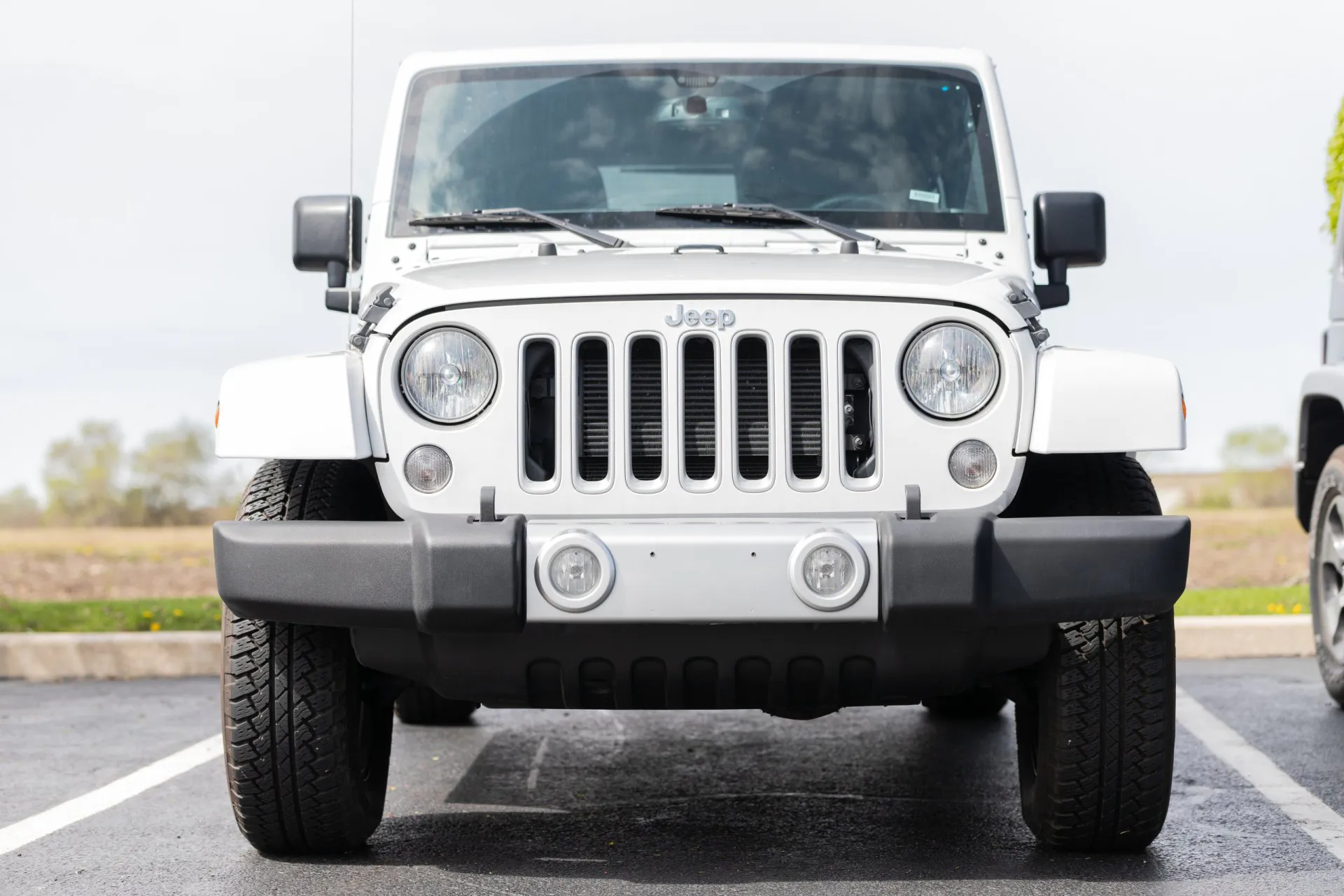
FIXD App Engine Reliability: 9/10
Owner-Reported Reliability: 8/10
KBB Value: $21,775
Fuel Economy: 18 mpg
Annual Maintenance/Repair: $625
Safety Rating: 3/5
Not only does the FIXD Reliability score step up from eight to nine in 2017, but the owner-reported score remains high at eight (though it does represent a 1-point drop versus 2016), market values post a $3,000 increase year-over-year, and annual maintenance costs decrease versus the 2016 model.
These 2017 Wranglers come in below average for annual days in the shop and for the percentage of owners who think they’re expensive to repair. A 2015 audio system overhaul increased the speaker count on all models, which 2017 owners appear to appreciate as 22% are fans of the stereo, far higher than the 9% average for this metric.
When it comes to expensive repairs ($500 or more), there is a 20% chance of it being engine-related in 2017, which correlates with the most common trouble codes. One of them, DTC P0128, indicates the thermostat is not regulating engine coolant temperature properly. Our P0128 explainer video dives into the details, but expect to pay around $500 to have the thermostat fixed.
DTC P0456, an evaporative emission control system issue, specifically deals with the ESIM and can often be addressed by tightening the gas cap. If DTC P06DE pops up, it may be a faulty engine oil pump, replacement of which can run over $1,000.
Recalls for the 2017 Wrangler are on the low side with five. An issue with the front airbags and seat belt pretensioners not operating properly during a crash is the most significant as it impacted about 183,000 vehicles.
2012-2016 Jeep Wrangler
FIXD App Engine Reliability: 6-8/10
Owner-Reported Reliability: 8-9/10
KBB Value: $12,677-$18,597
Fuel Economy: 18 mpg
Annual Maintenance/Repair: $556-$766
Safety Rating: 3/5
Several years into third-generation Wrangler production – 2012 – Jeep dropped the existing 3.8L V6 and introduced the 3.6L Pentastar V6, an engine that remains in production today. At the same time, the automaker replaced the 4-speed automatic transmission with a new 5-speed unit.
Typically this sort of powertrain work would send reliability down the tubes. But starting in 2012, the Wrangler did the opposite, going on a reliability tear from 7/10 in 2011 up to 9/10 by 2016. Owners agree, reporting eights and nines for reliability throughout this period.
The new powertrain also brought a slight fuel efficiency improvement, pushing the average up from 17 mpg in 2011 to 18 in 2012. Meanwhile, Kelley Blue Book values move steadily in the right direction and annual maintenance costs stay flat, around the average of $623 per year.
Though this whole range of Wranglers represents solid purchase values, the 2014 model year is of particular note thanks to typical mileage of just under 100,000 and a KBB value of about $14,000.
Owners report using their Wrangler as a family vehicle to a higher degree than normal – 20-30% – between 2012 and 2016. This is interesting because Jeep delivered a mid-cycle refresh in 2011 that brought family-friendly features like heated seats, additional sound insulation, and automatic climate control.
The most common DTC owners of these Wranglers will see is P0128 for a faulty thermostat. Part of the system that manages engine coolant temperature, a new thermostat runs about $500 at a shop, though DIYers can shave about $100 off that. This P0128 explainer video provides more detail on what to expect.
DTC P0456, which means a new ESIM assembly may be needed, is another one to watch out for – you can dig into the details with this DTC P0456 explainer video. If DTC P0430 pops, you may be looking at a new catalytic converter with replacement running between $1,500 and $2,000.
As for recalls, there were 10 issued for the 2012 Wrangler and seven for the 2013 model with a front airbag issue that impacted 1.7 million vehicles being the most significant for both years.
A problem with the seat belt buckle separating from the seat frame, that affected 11,000 vehicles, was common to the recalls for 2014 and 2015 Wranglers. And while there were only four recalls issued for the 2016 Wrangler, there was a problem with the driver-side airbag not deploying which impacted about 7,000 vehicles.
2010 Jeep Wrangler
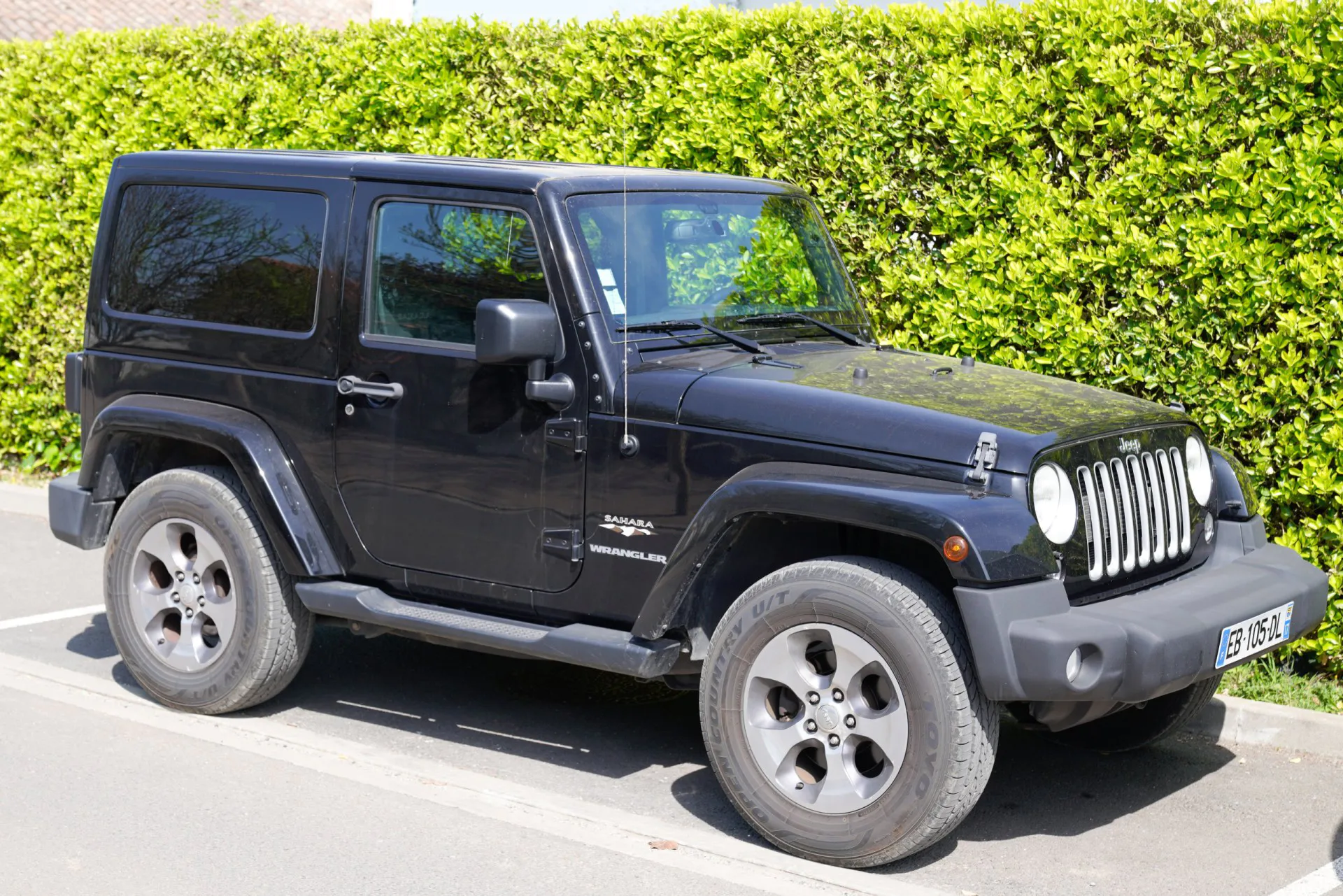
FIXD App Engine Reliability: 6/10
Owner-Reported Reliability: 7/10
KBB Value: $9,476
Fuel Economy: 17 mpg
Annual Maintenance/Repair: $667
Safety Rating: 4.3/5
After Jeep ironed out the reliability issues from the start of third-gen Wrangler production in 2007, reliability improved dramatically by 2010 with the FIXD Reliability score jumping four points over the prior year. Owners also reported a reliability improvement of one point for 2010 models (7/10).
Market value does dip slightly, but the 4.3/5 safety score is an all-time high for the Wrangler and annual maintenance costs are right around the average at $670. And although these Wranglers only show about 142,000 miles on the odometer, 27% of owners are confident their Jeeps are capable of hitting the 200,000-mile mark.
Illustrating the subjective nature of owner experiences, 60% of them say this 2010 model has barely any storage, which is relatively high, and curious as this was the same year Jeep added additional storage space under the center stack. So, if you’re looking to buy a used Wrangler, don’t rely too much on friend’s and family input.
As with many Wranglers, the EVAP system is the major culprit when it comes to CELs in 2010. The two most common DTCs, P0456 and P0457, indicate a new ESIM assembly may be needed at a cost of up to $560. But keep in mind these issues can sometimes be resolved simply by tightening the gas cap.
DTC P0430, another common code in 2010, means the catalytic converter is acting up and if it’s on the way out, a replacement catalytic converter can run upwards of $2,000.
There are 11 recalls out on the 2010 Wrangler. One of the more troubling issues has to do with the skid plates on models with automatic transmissions collecting debris that can lead to a fire due to the proximity of the catalytic converter. This recall impacted about 65,000 vehicles.
2006 Jeep Wrangler
FIXD App Engine Reliability: 5/10
Owner-Reported Reliability: 6/10
KBB Value: $6,465
Fuel Economy: 16 mpg
Annual Maintenance/Repair: $929
Safety Rating: 4/5
2006 marked the end of gen-two Wrangler production when Jeep dropped the four-cylinder powertrain option, making the inline-six its sole Wrangler option. Reducing complexity is a natural boon to reliability and it shows here with the 2006 models registering a 4-point jump for the FIXD Reliability score versus 2005.
Maintenance costs do err on the high side, but so does the safety score, and 25% of owners say their 2006 Wrangler is cheap to repair, which is the highest figure for this metric over 20 years. As well, 30% of those owners are confident their Jeep will hit 200,000 miles even though they only show, on average, 156,000 miles on the clock.
For 2006, there is an 8% chance of an expensive repair being related to the fuel system. That may not sound high but it is 2 ½ times higher than the average and in line with all three of the most common DTCs being fuel system-related.
First up is P0153, which indicates a malfunctioning oxygen sensor that can be repaired for less than $300. DTC P0456 and P0457 are both related to the EVAP system. Fixes could be as simple as tightening the gas cap, though a new ESIM assembly runs between $200 and $560. You can watch this DTC P0456 explainer video for more insight.
There are only three recalls for the 2006 Wrangler, but two of them are for clutch failure in models with the manual transmission that affected some 50,000 vehicles.
2003-2004 Jeep Wrangler
FIXD App Engine Reliability: 4-5/10
Owner-Reported Reliability: 9/10
KBB Value: $5,445-$5,522
Fuel Economy: 16 mpg
Annual Maintenance/Repair: $250-$583
Safety Rating: 3.7-4/5
These 20-year-old Wranglers saw reliability improve when a new 2.4L inline-4 and 4-speed automatic replaced the earlier 2.5L and 3-speed powertrain in 2003. The FIXD Reliability score moved from 1/10 in 2002 to 4/10 in 2003 and 5/10 in 2004, while owner-reported reliability also ticked up from 8/10 to 9/10 for both years.
KBB values stay flat during this stretch, but safety scores move up from 3.7/5 to 4/5 and annual maintenance costs for 2003 come in well below the average at just $250. And although the 2003 Wrangler is two decades old with relatively high mileage, annual time spent in the shop averages only half a day.
Correlating with a mid-cycle refresh of the Wrangler lineup in 2003 that brought redesigned seats and the first Rubicon model, 33% of owners say the seats are comfortable and 50% use their Jeep primarily for outdoor and off-road use – both of which are relatively high for the respective category.
As for problem areas, DTC P0442 is the most common cause of a CEL for these Wranglers. It indicates a medium-sized leak (0.2”-0.4” diameter) within the EVAP system versus DTC P0456 that is caused by a small leak of around 0.02” in diameter. Both of these DTCs are often caused by a loose gas cap.
If you see trouble code P0301, it means an engine misfire has been detected. This problem can cause serious damage if left unaddressed. Fortunately, it is typically remedied by replacing the spark plugs, which runs less than $200. We dive into the details with this P0301 explainer video.
There were four recalls issued for the 2003 Wrangler including one for non-conforming amber side reflectors that impacted about 65,000 vehicles. The 2004 model had just three recalls including one for a leaking brake fluid master cylinder that affected 7,000 vehicles.
The Worst Years of the Jeep Wrangler

Working with the same information to determine the best Jeep Wranglers, we’ve compiled the list of model years to avoid. You can expect more issues with reliability, higher maintenance bills, and in some cases lower safety ratings with these poor-performing Wranglers.
2001-2002 Jeep Wrangler
FIXD App Engine Reliability: 1/10
Owner-Reported Reliability: 4-8/10
KBB Value: $5,905-$6,974
Fuel Economy: 16 mpg
Annual Maintenance/Repair: $250-$714
Safety Rating: 3.7/5
With the lowest possible FIXD Reliability scores for both years, it’s little wonder the 2001 and 2002 Jeep Wranglers sit atop our list of worst model years. The owner-reported score did jump in 2002 but was just 4/10 in 2001. Powertrain revisions in 2000 were likely responsible for some of these reliability headaches.
On top of that, these models have the worst fuel economy of all Wranglers, market values move in the wrong direction, and annual maintenance costs jump to over $700. Finally, the 2001 models only average 100,000 miles, which is quite low for such an old vehicle but could be due to 50% of owners primarily using their Wrangler for off-roading.
When it comes to expensive repairs, there is a 10% chance of it being fuel system-related on the 2004 Wrangler – a relatively high percentage for this metric. And it aligns with all three of the most common DTCs being due to this system.
Fortunately, DTCs P0442, P0455, and P0456 – which specifically relate to EVAP system leaks – are frequently caused by a loose gas cap. However, these codes may also require new purge valves or ESIM assemblies which can ratchet up the repair costs.
Of the seven recalls for the 2001 Wrangler, the most troubling is a defect with the intake and exhaust manifold design on the 4.0L engine that allows debris to accumulate, an issue that affected over one million vehicles. There were six recalls on the 2002 model with one involving water collecting inside the ignition switch.
2005 Jeep Wrangler
FIXD App Engine Reliability: 1/10
Owner-Reported Reliability: 8/10
KBB Value: $6,728
Fuel Economy: 16 mpg
Annual Maintenance/Repair: $875
Safety Rating: 4/5
Towards the end of second-gen Wrangler production, Jeep swapped the 5-speed manual transmission for a new 6-speed unit. This likely played a role in the FIXD Reliability score diving from five in 2004 to just one in 2005.
Owners also reported a decline in reliability, annual maintenance costs are $200 higher than average, and these Jeeps fall into the period where average fuel economy measures a measly 16 mpg. Those owners are also unimpressed with the stereo on their Wranglers with 50% saying it stinks versus an average of 17% for this survey question.
The EVAP system continues to be a problem area on these 2005 Wranglers with DTC P0456 as the most common cause of a CEL. In many cases, it can be resolved by simply tightening the gas cap, but if not, check out our DTC P0456 explainer video for more help.
DTC P0153, a low-severity problem that means it’s time for a new oxygen sensor, is another common code that shouldn’t cost more than $300 to fix.
However, DTC P0700 is a whole different story. It means the transmission control module isn’t working properly and repairs can run upwards of $800. This correlates with a 25% chance of an expensive repair being transmission-related in 2005, which is more than twice the average for this metric and highlights the importance of servicing your transmission.
There were only two recalls on the 2005 Wrangler and one of them, that impacted a quarter-million vehicles, involved the failure of the automatic transmission cup plug which would cause the vehicle to roll away if the parking brake was not engaged.
2007-2009 Jeep Wrangler
FIXD App Engine Reliability: 2-4/10
Owner-Reported Reliability: 6-8/10
KBB Value: $7,912-$10,225
Fuel Economy: 17 mpg
Annual Maintenance/Repair: $750-$967
Safety Rating: 4.25-4.3/5
Typically, when an automaker introduces a new vehicle generation, reliability goes haywire and the 2007-2009 Jeep Wranglers certainly fit that mold. 2007 was year one of the third-gen Wrangler and marked a steady decline of the FIXD Reliability score from 5/10 in 2006 to 2/10 by 2009.
Owner-reported reliability is more of a mixed bag, as is the case with any subjective data, particularly in 2008 when it deviates from the FIXD Reliability score by five points. Analyzing the survey data shows that 50% of 2008 Wrangler owners think their Jeep is ready for a cross-country road trip while 6% say theirs can only handle local driving.
But when we dig into the data collected by thousands of FIXD devices installed in Jeep Wranglers, it turns out the 2008 model registered nearly 13,000 DTCs that year. This is more than twice the average count of trouble codes across 20 model years – objectively – the 2008 Wrangler is not very reliable.
Further correlation with this analysis is provided by the fact that the 2007 and 2008 Wranglers spend more than two days in the shop each year. As well, all three model years in this range have above-average annual service bills with the 2008 Wrangler coming in at $967, the highest of any model year.
Two of the most common DTCs during this period, P0430 and P0420, indicate its time for a new catalytic converter. An important part of the exhaust system, replacing the catalytic converter can cost $2,000, though our DTC P0420 guide provides education on how to reduce that figure.
Like so many other model years, DTC P0456 is frequently encountered by owners of 2007, 2008, and 2009 Wrangler owners. It likely means the ESIM assembly is due for replacement, work that costs between $200 and $600 to have done.
The 2007 Wrangler has 10 recalls open for it, including one for an overheating transmission problem that impacted 88,000 vehicles. In 2008, the Wrangler received nine recalls along with 1,225 customer complaints and eight open investigations – all of which are relatively high figures for the respective category.
Though the 2009 Wrangler has “only” seven recalls from the NHTSA, five of those are related to airbags that collectively impact more than five million vehicles.
2011 Jeep Wrangler
FIXD App Engine Reliability: 4/10
Owner-Reported Reliability: 7/10
KBB Value: $12,857
Fuel Economy: 17 mpg
Annual Maintenance/Repair: $750
Safety Rating: 3/5
There were no powertrain updates in 2011, but the 2011 Jeep Wrangler posted a significant drop in the FIXD Reliability score which is part of the reason it earns a thumbs down. Other reasons include an abysmal safety score and above-average annual maintenance costs.
Finally, 25% of owners don’t expect their Wrangler to hit 200,000 miles. This is a relatively high percentage for this survey question and considering these model years only average 107,000 miles, it speaks to low owner-confidence with long-term reliability.
EVAP system issues, a common thread of Wrangler woe across 20 years of production, continued to rear its leaky head in 2011. DTCs P0455, P0456, and P0457 are the three most common creators of CELs this model year. All three mean there is a leak in the EVAP system that can often be resolved by screwing down the gas cap properly.
The NHTSA issued 11 recalls for the 2011 Wrangler including one for corrosion in the side mirror heating elements. This problem can lead to a fire and affected over 300,000 vehicles.
2018 Jeep Wrangler
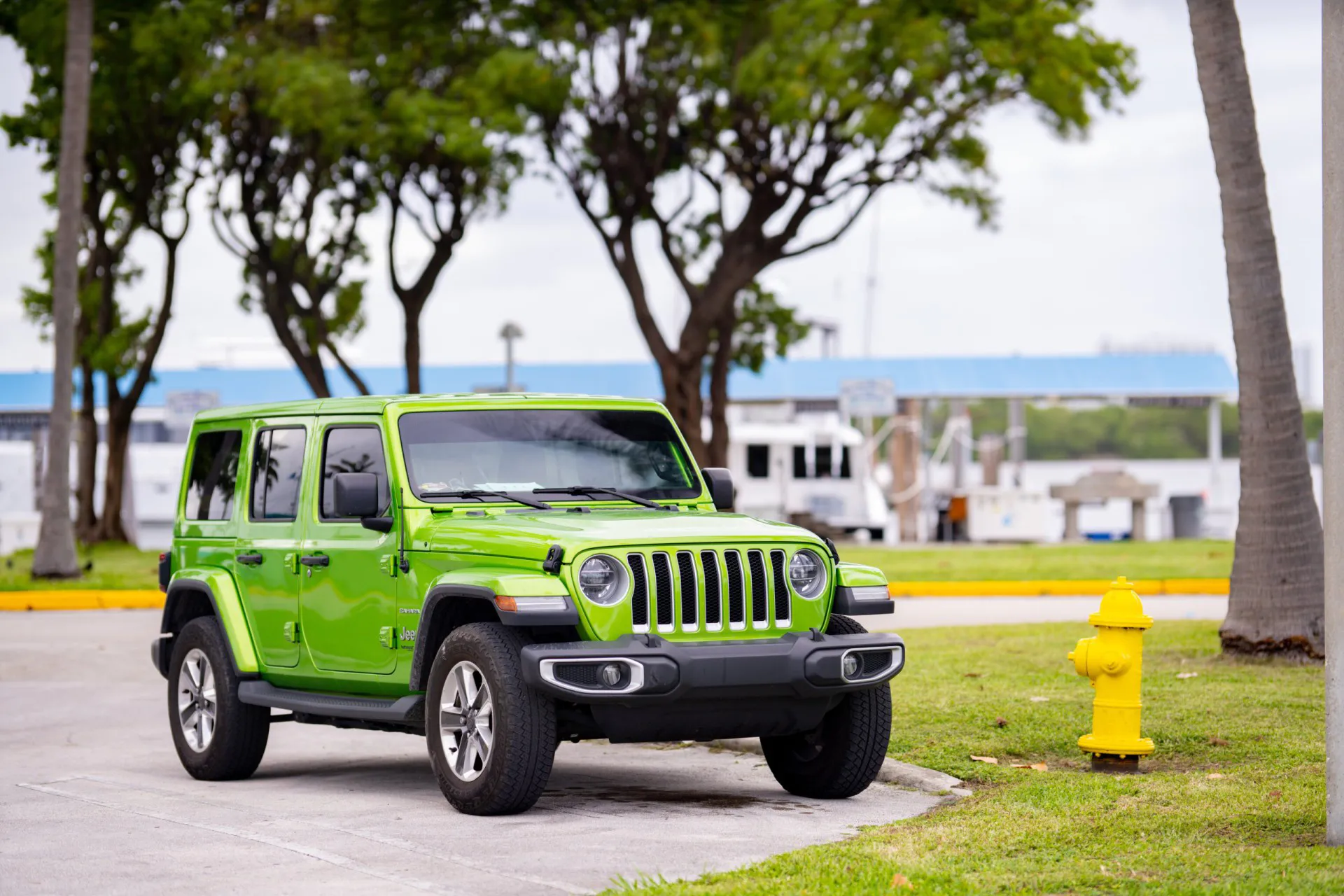
FIXD App Engine Reliability: 7/10
Owner-Reported Reliability: 10/10
KBB Value: $24,975
Fuel Economy: 20 mpg
Annual Maintenance/Repair: $485
Safety Rating: 3/5
As our “best of the worst” Jeep Wranglers, the 2018 model year isn’t all bad, but we still can’t recommend you buy one. For one thing, the safety score is terrible and for another, the FIXD Reliability score drops two points versus the prior year. Yes, owner-reported reliability is perfect, but that can be misleading. Some owners may believe that their car is as reliable simply because it’s only 5 years old.
A 7/10 FIXD Reliability score on a 5 year old vehicle is not unheard of or, truly, all that bad but, why not buy a 2019-2021 and get a 8-10/10 for reliability and a better safety rating?
There are bright points like fuel economy moving up to 20 mpg thanks to powertrain updates that arrived with the new fourth-gen Wrangler in 2018. But the teething issues cannot be ignored as evidenced by 12 recalls, five NHTSA investigations, and almost 1,500 customer complaints for this model year.
As for CELs, causes range from Usual Suspect DTC P0456 for a leak in the EVAP system to DTC P00FD which indicates an issue with the vehicle battery connection. If DTC P0300 pops, it’s time for new ignition coils, a job that should cost less than $200 to have repaired. Our DTC P0300 guide provides more insight into what to expect with this.
FAQs
What years of the Jeep Wrangler have engine and/or transmission problems?
In 2007, the third-gen “JK” Jeep Wrangler arrived with a clean-sheet redesign that included a new 3.8L V6 powertrain. As is so often the case, this caused reliability problems as evidenced by the 50% chance of an expensive repair being engine-related on the 2007 Wrangler. That is the highest percentage for this metric versus any other model year by far.
As for transmission trouble, watch out for the 2001 Wrangler. It has a 33% chance of the transmission being the cause of a $500+ repair bill, a figure that is close to three times the average for this category.
What is considered high mileage for a Jeep Wrangler?
Though odometer readings are not the only factor at play when determining what is considered high mileage for a vehicle, it’s a good place to start. Looking over 20 years of Wrangler data, we can see that 200,000 miles would definitely be a high-water mark.
Across those data points, the average Wrangler shows 119,000 miles on the clock and only the 2000 model year hits 200,000. In 2003 and 2004, this figure averaged about 175,000 miles, while most other years have far lower mileage. But in a show of the famous Jeep customer loyalty, 25% of owners think their Jeep will hit 200,000 miles versus just 4% who don’t.
What other vehicles should I consider?
Aside from the recently unveiled Ford Bronco, the Jeep Wrangler has few direct competitors though the smaller Ford Bronco Sport is one of them, particularly in Badlands trim which has legitimate off-road capability. Other potential options include the Subaru Forester for those who prefer more daily comfort and a Ford F-150 for those who want serious utility to go with their 4WD needs.
Within the Jeep family, the Grand Cherokee offers ample off-road skills and plenty of luxury, while the Toyota Tacoma – particularly in TRD Pro trim – blends utility and off-roading into a midsize package. No matter which road you choose, be sure to read up on how to tread lightly when you do hit the trail.
What owners of the Jeep Wrangler like to use their car for:
| Frequent Use Categories: | How Useful? (Out of 5 Stars) |
| Family Vehicle | *** |
| Lots of Driving (travel/long commute) | *** |
| Hauling/Towing | * |
| Office on Wheels | * |
| Sport/Fast Driving | * |
| Luxurious Driving | * |
| Outdoor/Off-Road | **** |
A Note About Data and Information Sources
This article has many details about Jeep Wrangler reliability; here’s what we used for our assumptions and recommendations.
- FIXD Reliability Score & Data: Engine reliability information is captured via the FIXD App.
The FIXD Reliability Score is calculated using the number of DTCs per year, weighted by mileage. This is then turned into a scale of 1-10 for easy graphing.
This is an objective score.
- Owner Reliability Score & Data: This data is the result of surveying Jeep Wrangler owners who use FIXD.
The Owner Reliability Score comes straight from owners of the Jeep Wrangler.
This is a subjective score.
To determine the Owner Reliability Score we ask each car owner:
How reliable would you say your Jeep Wrangler is?
a. Just point A to point B driving
b. A Daily Commuter
c. Good for a 100-mile road trip
d. Good for a 500-mile road trip
e. I could take a cross-country road trip, no problem
From here we translate their answers into the Owner Reliability Score:
a. = 2
b. = 4
c. = 6
d. = 8
e. = 10
Keep in mind, owners may think their car is more or less reliable than it actually is.
One potential problem is that people often buy the same make or model they are used to when they go car shopping, just a newer year.
Ford, for instance, has a number of consumer loyalty awards for the Ford F-Series, Ford Mustang, and Ford Expedition.
Car owners may be so loyal to the make or model they currently own that they would have trouble accurately comparing their cars’ reliability to others.
It’s for this reason that we ask car owners a question that is relative to mileage rather than relative to other cars.
Still, be mindful of the accuracy of these Owner Reliability Scores, people’s perceptions and unconscious blindspots can skew data.
We suggest looking at both the FIXD Reliability Score and the Owner Reliability Score for this reason.
- KBB Value: Average private-seller valuations as supplied by Kelley Blue Book (KBB), based on a Jeep Wrangler with typical mileage for that respective model year.
- Fuel Economy: Mileage-per-gallon estimates according to the EPA MPG on Fueleconomy.gov
- Annual Maintenance/Repair: Upkeep expenses as reported by surveyed Jeep Wrangler owners
- Safety Rating: Crash test data collected and reported by NHTSA. We average all ratings for each year to come up with a simplified, average safety score. This makes it easier to look at on a graph.
References
- Jeep Wrangler model-specific information. Retrieved June 14, 2023, from https://www.edmunds.com/
- Jeep Wrangler model-specific recall information. Retrieved June 14, 2023, from https://www.nhtsa.gov/recalls
- Jeep Wrangler model-specific information. Retrieved June 14, 2023, from https://www.auto-brochures.com
- Jeep Wrangler model-specific information. Retrieved June 14, 2023, from https://media.stellantisnorthamerica.com/newsroom.do?id=4&mid=4

Niel Stender grew up doing replacement work on his old Cherokee and sweet Mitsubishi Starion, which led to a degree in mechanical engineering and a job at Ford as a vehicle dynamics engineer. His writing infuses that automotive background with sales and marketing experience. Writing about cars for close to a decade now, he enjoys digging into some of the more technical mechanical systems under the hood and throughout a vehicle.

